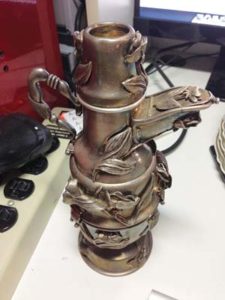
DB from Oxnard sent me this photograph of a most beautiful mystery silver item, which appears to be a tea or coffee pot. But in this little item contains a whole story of Judaica silver. This beautiful, tarnished orphan is typical of Judaica silver pieces in the midst of political regimes which forbade the practice of the religion. The little piece hides many ceremonial Jewish silver forms.
The missing top piece, the finial, latched off to become a dreidel. The top of the piece is a hidden, removable spice holder. The part with the spout is a little lamp when removed, which contains the eternal flame. At the back of the oil lamp is a hidden megillah, a tiny scroll reciting the biblical narrative of Esther, read at the festival of Purim. The main body holds an etrog, the citrus medica, used by Jews during the Sukkot week.
The leaf design of the “pot” is citrus leaves and blossoms. The belly of the pot unhinges to reveal tiny little Seder plates, with a tiny menorah hidden underneath, all with citrus leaf and blossom relief. Each object represents the ceremonial observance of religious ceremonies. These objects collectively and when assembled in a delightful puzzle are meant to be beautiful, to reflect the idea of Hiddur Mitzvah. Ceremonies should be beautiful, and this little hidden beauty was designed not for the “shul,” but for the home. The home, in Judaism, is the center of the religion, thus the intimate scale of this piece.
Now comes the sad side of what this little beauty represents. The owners called it a hidden synagogue or a secret temple. I emphasize the importance of the word “hidden.” Because reading the silver hallmarks underneath, I discovered the piece to have been made in the style of Georg Ruttinger, a silver maker in Hanau Germany, who specialized in Judaic silver from 1926. This object may be a copy of Ruttinger’s original conception, because the counter-stamp reads Israel .925 (sterling in 925 parts silver) which makes this a respectful copy done after Ruttinger in Israel, meaning, a copy done in his style, later. Ruttinger’s hallmarks are on this piece as well, which points to a date of 1926 in Germany for the piece’s initial creation. What a time for the birth of a piece of Judaica!
Now comes the historical, political part. What happened in Germany 1920-30 became Hitler’s rise to power, especially enforced by the Nazi S.A., and S.S. set up to intimidate the Slavic, the Romani and the Jews. This paramilitary, called “The Brownshirts,” became responsible for terrorizing the Jews, which culminated in the notorious Kristallnacht in 1938, where 7,500 Jewish businesses, 200 synagogues, 29 department stores owned by Jews were destroyed and 30,000 Jewish men arrested. So now we see in frighteningly beautiful visual terms, in this little object, why these Jewish ceremonial objects as elements in the vessel became hidden. This symbolizes the faith and ingenuity of the Jewish people in the face of persecution to protect the important symbols of Jewish life.
Spanish Jews during the Inquisition created such little hidden symbolic silver vessels to celebrate the high holy days. “Judaizing,” doing a ceremony in the manner of the Jews, might land you in prison or worse, from the Inquisition to the history of this little piece, originally created in 1930.
This piece is a modern version of the 1930’s original, more than likely by the Israeli silversmith Yossi Swed, of Swed Master’s Workshop in Jerusalem. This site states that only 65 of these were made, each a private commission.
I estimate the value of such a piece in solid sterling in the five figures.